Enceladus

"The south polar terrain is marked by a striking set of 'blue' fractures and encircled by a conspicuous and continuous chain of folds and ridges, testament to the forces within Enceladus that have yet to be silenced."[1]
"The mosaic was created from 21 false-color frames taken during the Cassini spacecraft's close approaches to Enceladus on March 9 and July 14, 2005. Images taken using filters sensitive to ultraviolet, visible and infrared light (spanning wavelengths from 338 to 930 nanometers) were combined to create the individual frames."[1]
"The mosaic is an orthographic projection centered at 46.8 degrees south latitude, 188 degrees west longitude, and has an image scale of 67 meters (220 feet) per pixel. The original images ranged in resolution from 67 meters per pixel to 350 meters (1,150 feet) per pixel and were taken at distances ranging from 11,100 to 61,300 kilometers (6,900 to miles) from Enceladus."[1]
Theoretical Enceladus
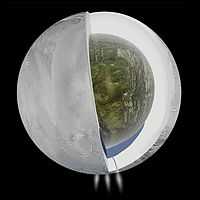
"This diagram illustrates the possible interior of Saturn's moon Enceladus based on a gravity investigation by NASA's Cassini spacecraft and NASA's Deep Space Network, reported in April 2014. The gravity measurements suggest an ice outer shell and a low density, rocky core with a regional water ocean sandwiched in between at high southern latitudes."[2]
"Views from Cassini's imaging science subsystem were used to depict the surface geology of Enceladus and the plume of water jets gushing from fractures near the moon's south pole."[2]
"Enceladus is 313 miles (504 kilometers) in diameter."[2]
Strong forces
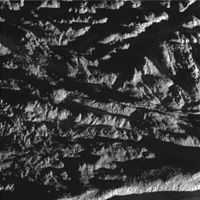
The image at the right shows a series of intense ridges in the south polar region, but the image has not been validated or calibrated. A validated/calibrated image was to be archived with the NASA Planetary Data System in 2009. No such image occurs in the Cassini data base unless it is in another such database.
Electromagnetics
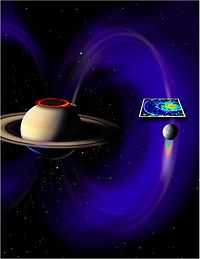
"This artist's concept shows a glowing patch of ultraviolet light near Saturn's north pole that occurs at the "footprint" of the magnetic connection between Saturn and its moon Enceladus. The footprint and magnetic field lines are not visible to the naked eye, but were detected by the ultraviolet imaging spectrograph and the fields and particles instruments on NASA's Cassini spacecraft. The footprint, newly discovered by Cassini, marks the presence of an electrical circuit that connects Saturn with Enceladus and accelerates electrons and ions along the magnetic field lines. In this image, the footprint is in the white box marked on Saturn, with the magnetic field lines in white and purple."[3]
"A larger white square above Enceladus shows a cross-section of the magnetic field line between the moon and the planet. This pattern of energetic protons was detected by Cassini's magnetospheric imaging instrument (MIMI) on Aug. 11, 2008."[3]
"The patch near Saturn's north pole glows because of the same phenomenon that makes Saturn's well-known north and south polar auroras glow: energetic electrons diving into the planet's atmosphere. However, the "footprint" is not connected to the rings of auroras around Saturn's poles (shown as an orange ring around the north pole in this image)."[3]
"The Cassini plasma spectrometer complemented the MIMI data, with detection of field-aligned electron beams in the area. A team of scientists analyzed the charged particle data and concluded that the electron beams had sufficient energy flux to generate a detectable level of auroral emission at Saturn. Target locations were provided to Cassini's ultraviolet imaging spectrograph team. On Aug. 26, 2008, the spectrograph obtained images of an auroral footprint in Saturn's northern hemisphere."[3]
"The newly discovered auroral footprint measured about 1,200 kilometers (750 miles) in the longitude direction and less than 400 kilometers (250 miles) in latitude, covering an area comparable to that of California or Sweden. It was located at about 65 degrees north latitude."[3]
"In the brightest image the footprint shone with an ultraviolet light intensity of about 1.6 kilorayleighs, far less than the Saturnian polar auroral rings. This is comparable to the faintest aurora visible at Earth without a telescope in the visible light spectrum. Scientists have not yet found a matching footprint at the southern end of the magnetic field line."[3]
Visuals
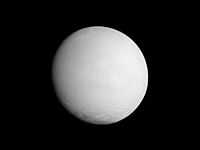
At right is Saturn's natural satellite, the rocky object, Enceladus.
"Enceladus, a moon of Saturn, has one of the highest known albedos of any body in the Solar system, with 99% of EM radiation reflected."[4]
"The Cassini spacecraft looks at a brightly illuminated Enceladus and examines the surface of the leading hemisphere of this Saturnian moon."[5]
"North on Enceladus (313 miles across, or 504 kilometers) is up and rotated 21 degrees to the right."[5]
"The image was taken in visible light with the Cassini spacecraft narrow-angle camera on Nov. 6, 2011. The view was obtained at a distance of approximately 67,700 miles (109,000 kilometers) from Enceladus and at a Sun-Enceladus-spacecraft, or phase, angle of 21 degrees. Image scale is 2,130 feet (649 meters) per pixel."[5]
Oranges
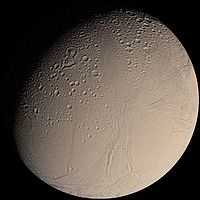
"This color Voyager 2 image mosaic shows the water-ice-covered surface of Enceladus, one of Saturn's icy moons. Enceladus' diameter of just 500 km would fit across the state of Arizona, yet despite its small size Enceladus exhibits one of the most interesting surfaces of all the icy satellites. Enceladus reflects about 90% of the incident sunlight (about like fresh-fallen snow), placing it among the most reflective objects in the Solar System. Several geologic terrains have superposed crater densities that span a factor of at least 500, thereby indicating huge differences in the ages of these terrains. It is possible that the high reflectivity of Enceladus' surface results from continuous deposition of icy particles from Saturn's E-ring, which in fact may originate from icy volcanoes on Enceladus' surface. Some terrains are dominated by sinuous mountain ridges from 1 to 2 km high (3300 to 6600 feet), whereas other terrains are scarred by linear cracks, some of which show evidence for possible sideways fault motion such as that of California's infamous San Andreas fault. Some terrains appear to have formed by separation of icy plates along cracks, and other terrains are exceedingly smooth at the resolution of this image. The implication carried by Enceladus' surface is that this tiny ice ball has been geologically active and perhaps partially liquid in its interior for much of its history. The heat engine that powers geologic activity here is thought to be elastic deformation caused by tides induced by Enceladus' orbital motion around Saturn and the motion of another moon, Dione."[6]
Infrareds

"The right-hand image shows a dramatically improved view of heat radiation from a warm fissure near the south pole of Saturn's icy moon Enceladus. It was obtained by NASA's Cassini spacecraft during its Nov. 21, 2009, flyby of that moon. The fissure, named Baghdad Sulcus, is one of four so-called "tiger stripe" features that emit jets of water vapor and ice particles. The tiger stripe runs from the upper left to the lower right of the image. The infrared map, obtained by Cassini's composite infrared spectrometer, is nearly 10 times more detailed than the image on the left, which was the best previous map of heat from the fissures. That image was obtained in March 2008."[7]
"The new data show that broad swaths of heat previously detected by the composite infrared spectrometer are confined to a narrow, intense region no more than a kilometer (half a mile) wide along the fracture. The thermal image also reveals that the strength of the signal varies considerably along the length of this fissure segment. The composite infrared spectrometer data indicate that the temperature along Baghdad Sulcus reached more than 180 Kelvin (about minus 140 degrees Fahrenheit)."[7]
"The new map shows how the surface glows at 10 to 16 micron wavelengths of radiation along a 40-kilometer (25-mile) length of Baghdad Sulcus. This covers a region about 10 kilometers to 5 kilometers (6 miles to 3 miles) in width, with the smallest features on the thermal map measuring less than 1 kilometer (half a mile) across. The older March 2008 map covered a larger area but showed no details smaller than about 5 to 9 kilometers (3 to 6 miles) across. The approximate area covered by the November 2009 scan is shown on the March 2008 map by a green rectangle."[7]
"The brightest colors in both maps do not correspond directly to the higher temperatures, but rather to a combination of higher temperatures and larger areas of warm surface material. The intensity of heat radiation increases as the color shades from violet to red to orange to yellow. No internal heat was detected in the darkest violet regions, and uncolored regions were not mapped by Cassini's composite infrared spectrometer. The background image is derived from visible-light images taken by Cassini's imaging science subsystem cameras in July 2005: alignment of the infrared data with the visible-light map is approximate."[7]
" Analysis of the total amount of infrared energy and the relative amounts of radiation measured at different wavelengths shows that the highest temperatures along Baghdad Sulcus are limited to a region no more than tens of meters (yards) across. Most of the heat measured by the infrared spectrometer probably arises from the warm flanks of the active fractures, rather than from the fractures themselves. The fractures themselves may be even warmer than the 180 Kelvin (minus 140 degrees Fahrenheit) detected - perhaps warm enough for liquid water to exist under the surface."[7]
"Cassini captured the data for this new mosaic during the spacecraft's close flyby of the moon on Nov. 21, 2009, at a distance of approximately 2,000 to 3,000 kilometers (1,200 to 1,800 miles) from Enceladus. The closeness of the flyby and the speed at which the spacecraft swept past the moon meant that Cassini had to use its thrusters to rotate the spacecraft to track Enceladus, rather than using its slower but more accurate reaction wheels."[7]
Astrochemistry
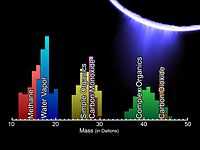
"The lower panel is a mass spectrum that shows the chemical constituents sampled in Enceladus' plume by Cassini's Ion and Neutral Mass Spectrometer during its fly-through of the plume on Mar. 12, 2008. Shown are the amounts, in atomic mass per elementary charge (Daltons [Da]), of water vapor, methane, carbon monoxide, carbon dioxide, simple organics and complex organics identified in the plume."[8]
Volcanoes


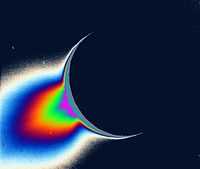

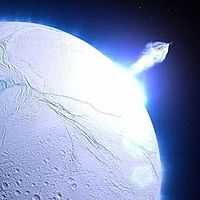
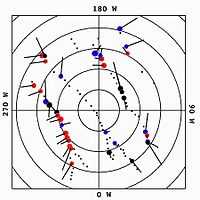
The second lower image on the right shows geyser emissions from the surface of Enceladus.
"Dramatic plumes, both large and small, spray water ice out from many locations along the famed "tiger stripes" near the south pole of Saturn's moon Enceladus. The tiger stripes are fissures that spray icy particles, water vapor and organic compounds."[9]
"More than 30 individual jets of different sizes can be seen in this image and more than 20 of them had not been identified before. At least one jet spouting prominently in previous images now appears less powerful."[9]
"This mosaic [third lower image on the right] was created from two high-resolution images that were captured by the narrow-angle camera when NASA's Cassini spacecraft flew past Enceladus and through the jets on Nov. 21, 2009."[9]
"The south pole of the moon lies near the limb in the top left quadrant of the mosaic, near the large jet that is second from left. Lit terrain seen here is on the leading hemisphere of Enceladus (504 kilometers, 313 miles across)."[9]
"The view was obtained at a distance of approximately 14,000 kilometers (9,000 miles) from Enceladus and at a sun-Enceladus-spacecraft, or phase, angle of 145 degrees. Image scale is 81 meters (267 feet) per pixel."[9]
"Recent Cassini images of Saturn's moon Enceladus backlit by the sun show the fountain-like sources of the fine spray of material that towers over the south polar region. The image was taken looking more or less broadside at the "tiger stripe" fractures observed in earlier Enceladus images. It shows discrete plumes of a variety of apparent sizes above the limb of the moon."[10]
"The greatly enhanced and colorized image shows the enormous extent of the fainter, larger-scale component of the plume."[10]
Four down on the right is a pair of images showing "[a] fine spray of small, icy particles emanating from the warm, geologically unique province surrounding the south pole of Saturn’s moon Enceladus[. It] was observed in a Cassini narrow-angle camera image of the crescent moon taken on Jan. 16, 2005. Taken from a high-phase angle of 148 degrees -- a viewing geometry in which small particles become much easier to see -- the plume of material becomes more apparent in images processed to enhance faint signals [right image of the pair]."[11]
"Though the measurements of particle abundance are more certain within 100 kilometers (60 miles) of the surface, the values measured there are roughly consistent with the abundance of water ice particles measured by other Cassini instruments (reported in September, 2005) at altitudes as high as 400 kilometers (250 miles) above the surface."[11]
"The image at the left was taken in visible green light. A dark mask was applied to the moon's bright limb in order to make the plume feature easier to see."[11]
"The image at the right has been color-coded to make faint signals in the plume more apparent. Images of other satellites (such as Tethys and Mimas) taken in the last 10 months from similar lighting and viewing geometries, and with identical camera parameters as this one, were closely examined to demonstrate that the plume towering above Enceladus' south pole is real and not a camera artifact. The images were acquired at a distance of about 209,400 kilometers (130,100 miles) from Enceladus. Image scale is about 1 kilometer (0.6 mile) per pixel."[11]
The fountains "of water ice blast thousands of kilometres above the surface of Saturn's tiny moon Enceladus. It is thought that the pull of Saturn's powerful gravity distorts the moon and heats the interior, forming an underground ocean. When this reservoir of water contacts the vacuum of space it vaporises and explodes above the moon. Any liquid water freezes instantly. Images of the ice fountains were first captured by the Cassini probe."[12]
The sixth image down on the right is a diagram that "plots the source locations of the geysers scientists have located on Enceladus' south polar terrain."[13]
"The 36 most active geyser, or jet, sources are marked by circles and color coded by the behavior of the grains erupting from the geysers. Other, less active sources are marked by small black squares."[13]
"Red sources produce structures that lead Enceladus in its orbit, blue sources produce particles that trail the moon, and black sources produce both. Circle size is proportional to the source activity level. Latitudes are plotted as concentric circles centered on the south pole at 5-degree intervals."[13]
"Lines emanating from sources represent the projection of a source's central emission vector onto Saturn's ringplane -- that is, the direction of a source's emission projected onto a plane passing through Saturn's equator. In this reference frame, Saturn is down and Enceladus' orbital motion to the right."[13]
Saturn system
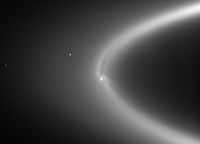
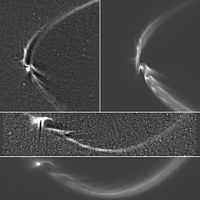
"Wispy fingers of bright, icy material reach tens of thousands of kilometers outward from Saturn's moon Enceladus into the E ring, while the moon's active south polar jets continue to fire away."[14]
"This astonishing, never-before-seen structure is made visible with the sun almost directly behind the Saturn system from Cassini's vantage point. The sun-Enceladus-spacecraft angle here is 175 degrees, a viewing geometry in which structures made of tiny particles brighten substantially."[14]
"These features are very likely the result of particles injected into Saturn orbit by the Enceladus geysers: Those injected in the direction of the moon's orbital motion end up on larger, slower orbits and trail Enceladus in its orbit, and those injected into the opposite direction end up smaller, faster orbits and lead Enceladus. (Orbital motion is counter-clockwise.) In addition, the configuration of wisps may hint at an interaction between Saturn's magnetosphere and the torrent of particles issuing from Enceladus."[14]
"In addition to the wisps, another unexpected detail is the dark gore in the center of the ring, following the moon in its orbit, likely brought about by the sweeping action of Enceladus as it orbits in the center of the E ring."[14]
"The view looks down onto Enceladus (505 kilometers, or 314 miles across) from about 15 degrees above the ringplane. Tethys (1,071 kilometers, or 665 miles across) is visible to the left of Enceladus."[14]
"The image was taken in visible light with the Cassini spacecraft wide-angle camera on Sept. 15, 2006, at a distance of approximately 2.1 million kilometers (1.3 million miles) from Enceladus. Image scale is 128 kilometers (80 miles) per pixel."[14]
Regarding the second set of images down on the right, "This collage, consisting of two Cassini images of long, sinuous, tendril-like features from Saturn's moon Enceladus and two corresponding computer simulations of the same, illustrates how well the structures, and the sizes of the particles composing them, can be modeled by tracing the trajectories of tiny, icy grains ejected from Enceladus' south polar geysers."[5]
"The figures labeled "a" and "c" are computer-enhanced images of the tendril structures near Enceladus that were taken at high solar phase angle (174 and 170 degrees, respectively); figures "b" and "d" are synthetic (computer-generated) images produced by following the trajectories of tiny, icy particles ejected from the 36 most active geysers (representing the top 50 percent of the moon's total geysering activity) found on the south polar terrain. The match between real and synthetic images is quite good and strongly supports the suggestion that tendrils are produced by the moon's geysers."[5]
"Electromagnetic effects associated with electrical charges that collect on small grains embedded in a magnetosphere like Saturn's can modify the grains' trajectories. These effects are very sensitive to particle size, with smaller particles feeling the effects of charging more strongly than larger ones. The scale of the arc-like structures seen in the tendrils allows scientists to determine that the tendril particles are no smaller than about 0.5 microns (a micron is one millionth of a meter), a size consistent with that of E-ring particles found from other Cassini observations, both imaging and in situ."[5]
"Figure "a" is from the observation of 2006; "c" was taken on July 19, 2013 during Cassini's Earth-imaging event (see PIA17172). Orbital motion is counter-clockwise in all images."[5]
"We've been able to show that each unique tendril structure can be reproduced by particular sets of geysers on the moon's surface."[15]
Radiative dynamos
With "a diameter only slightly more than 300 miles, Enceladus just doesn’t have the bulk needed for its interior to stay warm enough to maintain liquid water underground."[16]
"With temperatures around 324 degrees below zero Fahrenheit, the surface of Enceladus is indeed frozen. However, in 2005 NASA's Cassini spacecraft discovered a giant plume of water gushing from cracks in the surface over the moon's south pole, indicating that there was a reservoir of water beneath the ice. Analysis of the plume by Cassini revealed that the water is salty, indicating the reservoir is large, perhaps even a global subsurface ocean. Scientists estimate from the Cassini data that the south polar heating is equivalent to a continuous release of about 13 billion watts of energy."[16]
"To explain this mysterious warmth, some scientists invoke radiation coupled with tidal heating. As it formed, Enceladus (like all solar system objects) incorporated matter from the cloud of gas and dust left over from our sun’s formation. In the outer solar system, as Enceladus formed it grew as ice and rock coalesced. If Enceladus was able to gather greater amounts of rock, which contained radioactive elements, enough heat could have been generated by the decay of the radioactive elements in its interior to melt the body."[16]
"Enceladus' orbit around Saturn is slightly oval-shaped. As it travels around Saturn, Enceladus moves closer in and then farther away. When Enceladus is closer to Saturn, it feels a stronger gravitational pull from the planet than when it is farther away. Like gently squeezing a rubber ball slightly deforms its shape, the fluctuating gravitational tug on Enceladus causes it to flex slightly. The flexing, called gravitational tidal forcing, generates heat from friction deep within Enceladus."[16]
"The gravitational tides also produce stress that cracks the surface ice in certain regions, like the south pole, and may be reworking those cracks daily. Tidal stress can pull these cracks open and closed while shearing them back and forth. As they open and close, the sides of the south polar cracks move as much as a few feet, and they slide against each other by up to a few feet as well. This movement also generates friction, which (like vigorously rubbing your hands together) releases extra heat at the surface at locations that should be predictable with our understanding of tidal stress."[16]
"To test the tidal heating theory, scientists with the Cassini team created a map of the gravitational tidal stress on the moon's icy crust and compared it to a map of the warm zones created using Cassini's composite infrared spectrometer instrument (CIRS). Assuming the greatest stress is where the most friction occurs, and therefore where the most heat is released, areas with the most stress should overlap the warmest zones on the CIRS map."[16]
"However, they don't exactly match."[17]
"For example, in the fissure called the Damascus Sulcus, the area experiencing the greatest amount of shearing is about 50 kilometers (about 31 miles) from the zone of greatest heat."[17]
"Enceladus' wobble, technically called "libration," is barely noticeable."[16]
"Cassini observations have ruled out a wobble greater than about 2 degrees with respect to Enceladus' uniform rotation rate."[17]
A "computer simulation [...] made maps of the surface stress on Enceladus for various wobbles, and found a range where the areas of greatest stress line up better with the observed warmest zones."[16]
"Depending on whether the wobble moves with or against the movement of Saturn in Enceladus' sky, a wobble ranging from 2 degrees down to 0.75 degrees produces the best fit to the observed warmest zones,"[17]
"The wobble also helps with the heating conundrum by generating about five times more heat in Enceladus’ interior than tidal stress alone, and the extra heat makes it likely that Enceladus' ocean could be long-lived, according to Hurford. This is significant in the search for life, because life requires a stable environment to develop."[16]
"The wobble is probably caused by Enceladus' uneven shape."[16]
"Enceladus is not completely spherical, so as it moves in its orbit, the pull of Saturn's gravity generates a net torque that forces the moon to wobble." [17]
"Enceladus' orbit is kept oval-shaped, maintaining the tidal stress, because of the gravitational tug from a neighboring larger moon Dione. Dione is farther away from Saturn than Enceladus, so it takes longer to complete its orbit. For every orbit Dione completes, Enceladus finishes two orbits, producing a regular alignment that pulls Enceladus' orbit into an oval shape."[16]
Research
Hypothesis:
- Enceladus has an ice sheet covering its entire surface.
Control groups

The findings demonstrate a statistically systematic change from the status quo or the control group.
“In the design of experiments, treatments [or special properties or characteristics] are applied to [or observed in] experimental units in the treatment group(s).[18] In comparative experiments, members of the complementary group, the control group, receive either no treatment or a standard treatment.[19]"[20]
Proof of concept
Def. a “short and/or incomplete realization of a certain method or idea to demonstrate its feasibility"[21] is called a proof of concept.
Def. evidence that demonstrates that a concept is possible is called proof of concept.
The proof-of-concept structure consists of
- background,
- procedures,
- findings, and
- interpretation.[22]
See also
References
- 1 2 3 Sue Lavoie (March 9, 2006). "PIA07800: Enceladus the Storyteller". Pasadena, California USA: NASA/JPL. Retrieved 2013-05-29.
- 1 2 3 Jon Nelson (3 April 2014). "Ocean Inside Saturn's Moon Enceladus". Pasadena, California USA: NASA/JPL. Retrieved 2015-05-19.
- 1 2 3 4 5 6 Sue Lavoie (20 April 2011). "PIA13765: Electrical Circuit Between Saturn and Enceladus (Artist's Concept)". Pasadena, California USA: NASA/JPL. Retrieved 2015-05-19.
- ↑ "Albedo, In: Wikipedia". San Francisco, California: Wikimedia Foundation, Inc. April 24, 2013. Retrieved 2013-05-01.
- 1 2 3 4 5 6 7 Tony Greicius (January 12, 2012). "Brilliant Enceladus". Washington, D.C.: NASA. Retrieved 2012-08-09.
- ↑ NASA/JPL/USGS (June 4, 1998). "PIA00347: Voyager 2 Color Image of Enceladus, Almost Full Disk". Reston, Virginia USA: NASA/JPL/USGS. Retrieved 2013-04-02.
- 1 2 3 4 5 6 Rebecca Whatmore (23 February 2010). "Zooming in on Heat at Baghdad Sulcus". Washington, DC USA: NASA. Retrieved 2015-05-19.
- ↑ Sue Lavoie (26 March 2008). "PIA10356: Enceladus Plume Neutral Mass Spectrum". Pasadena, California USA: NASA/JPL. Retrieved 2015-05-20.
- 1 2 3 4 5 Brian Dunbar (23 February 2010). "Bursting at the Seams". Retrieved 2015-03-02.
- 1 2 Sue Lavoie (9 March 2006). "PIA07759: Fountains of Enceladus - Image #2". Pasadena, California USA: NASA/JPL. Retrieved 2015-03-02.
- 1 2 3 4 Sue Lavoie (November 28, 2005). "PIA07760: Spray Above Enceladus". Pasadena, California: NASA and the Jet Propulsion Laboratory, California Institute of Technology. Retrieved 2012-07-22.
- ↑ Tomoyuki Uchiyama (10 March 2015). "Pin by Tomoyuki Uchiyama on 09 Astronomy". Pinterest. Retrieved 2015-05-19.
- 1 2 3 4 Tony Greicius (14 April 2015). "Tendril-producing Geysers on Enceladus' South Polar Terrain". Pasadena, California USA: NASA/JPL. Retrieved 2015-05-19.
- 1 2 3 4 5 6 Sue Lavoie (19 September 2006). "PIA08321: Ghostly Fingers of Enceladus". Pasadena, California USA: NASA/JPL. Retrieved 2015-05-19.
- ↑ Colin Mitchell (14 April 2015). "Icy Tendrils Reaching into Saturn Ring Traced to Their Source". Pasadena, California USA: NASA/JPL. Retrieved 2015-05-19.
- 1 2 3 4 5 6 7 8 9 10 11 Bill Steigerwald (October 6, 2010). "Saturn's Icy Moon May Keep Oceans Liquid with Wobble". Greenbelt, Maryland USA: NASA Goddard Space Flight Center. Retrieved 2014-03-28.
- 1 2 3 4 5 Terry Hurford (October 6, 2010). "Saturn's Icy Moon May Keep Oceans Liquid with Wobble". Greenbelt, Maryland USA: NASA Goddard Space Flight Center. Retrieved 2014-03-28.
- ↑ Klaus Hinkelmann, Oscar Kempthorne (2008). Design and Analysis of Experiments, Volume I: Introduction to Experimental Design (2nd ed.). Wiley. ISBN 978-0-471-72756-9. http://books.google.com/?id=T3wWj2kVYZgC&printsec=frontcover.
- ↑ R. A. Bailey (2008). Design of comparative experiments. Cambridge University Press. ISBN 978-0-521-68357-9. http://www.cambridge.org/uk/catalogue/catalogue.asp?isbn=9780521683579.
- ↑ "Treatment and control groups, In: Wikipedia". San Francisco, California: Wikimedia Foundation, Inc. May 18, 2012. Retrieved 2012-05-31.
- ↑ "proof of concept, In: Wiktionary". San Francisco, California: Wikimedia Foundation, Inc. November 10, 2012. Retrieved 2013-01-13.
- ↑ Ginger Lehrman and Ian B Hogue, Sarah Palmer, Cheryl Jennings, Celsa A Spina, Ann Wiegand, Alan L Landay, Robert W Coombs, Douglas D Richman, John W Mellors, John M Coffin, Ronald J Bosch, David M Margolis (August 13, 2005). "Depletion of latent HIV-1 infection in vivo: a proof-of-concept study". Lancet 366 (9485): 549-55. doi:10.1016/S0140-6736(05)67098-5. http://www.ncbi.nlm.nih.gov/pmc/articles/PMC1894952/. Retrieved 2012-05-09.
External links
| |||||||||||||||||||||||||||||||||||
![]() This is a research project at http://en.wikiversity.org
This is a research project at http://en.wikiversity.org
| |
Development status: this resource is experimental in nature. |
| |
Educational level: this is a research resource. |
| |
Resource type: this resource is an article. |
| |
Resource type: this resource contains a lecture or lecture notes. |
| |
Subject classification: this is a Geology resource. |